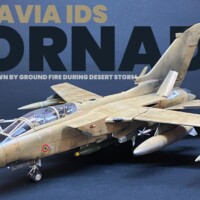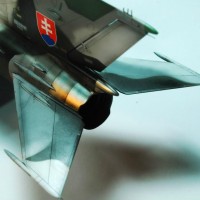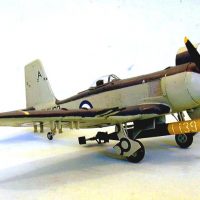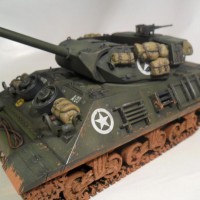34 - 1/48 Italeri Tornado IDS
This was a special build of one of my favourite plane's, bought for me by a friend as a surprise.
The scheme I decided on was of course the Italian one - and its a plane with a story, the only Italian aircraft that was shot down it the Gulf war. it was the first Italian airforce mission and a turned into a real mess.
I'll share the full story at the end of the post. But first the build.
I really wanted to go all out on this one - obviously as most planes it started in the cockpit. The detail was decent but I wanted to up it and don't have money to import fancy cockpit sets and aftermarket so decided to do it myself - especially on the seat that would be visible with an open cockpit so I used wires, putty, chocolate wrapper and some plastic to detail it up. I've added some photos of the kit seat next to my detailed one.
Next up were the wheel bays that were quite sparse so I added some wiring and boxes into it to make it a little more interesting.
I also drilled and added wiring to the Rio's controls according to references.
Now the cockpit was complete and I was pretty happy with everything.
[pic 11]
And onto the main build. The one part I had issues with was the intakes, the fit was way off and I'm not sure if it was because I didn't align things properly or because its a kit fit issue, but some plastic in there and some sprue goo and I was back on track.
Next was the engine painting and gave a nice burnt feel, was very happy with the outcome of these.
Then Painting time, I used my favourite method of black basing and mottling to try get some interest and a weathered feel to a brown desert bird. Primed it black with Vallejo black primer, then mottled white, then added yellows, reds and blues to the mottling to give variation and highlights.
Then on the underside thin layers of flat aluminium and on the top thin layers of Dessert Yellow so that the mottling is still faintly visible.
After a gloss clear coat I did the decals and panel lines and onto gear and weapons. I added wiring to the gear and mottling and decals to the weapons
Once all was together I started weathering, these desert birds got fairly dirty so I used oils, and Tamiya weathering sets to get a nice used look.
And that was that - off for a photoshoot which you can see more of in the gallery - I hope you enjoyed, sorry it was long, now as promised if you would like to read about the incident of MM7074 I'll add it here courtesy of the article by David Cenciotti - https://theaviationist.com/2021/01/18/legion-15-the-story-of-the-italian-air-force-tornado-ids-shot-down-during-operation-desert-storm/
A Tornado IDS of the Aeronautica Militare (Italian Air Force) was shot down on Jan. 18, 1991, during Italy's first mission in Operation Desert Storm.
Even though the fact that the Italian Air Force lost one Tornado IDS during the service's first Operation Desert Storm (ODS) air strike is very well known, the details about that mission that you can find online and in many aviation books are limited, if not completely wrong. In some cases, the only right thing is that the attack aircraft was shot down and the aircrew, pilot Maj. Gianmarco Bellini and navigator Capt. Maurizio Cocciolone ejected and became POW (Prisoners of War). For this reason, it's worth, once and for all, setting the records straight.
The Italian Air Force Tornado, deployed to Al Dhafra, UAE, as part of Operazione Locusta (the first operational employment in combat missions for the Aeronautica Militare since WWII), were tasked to launch their first mission in the night between Jan. 17 and 18, 1991.
Following the invasion and annexation of Kuwait by Iraq, on Sept. 25, 1990, the Italian Government had deployed 8 Tornado IDS (plus two spare) in the Persian Gulf, belonging to the 6º, 36º and 50º Stormo (Wing).
A Tornado of the Italian Air Force takes off from Gioia del Colle on the way to Al Dhafra at the beginning of Operazione Locusta.
Based on the official documentation, two four-ship formations were to take part in the mission: the first one, radio callsign “LEGION 15”, with four aircrews belonging to the 155° Gruppo (Squadron), and the second one, radio callsign “CAESAR 05”, with aircrews belonging to the 154° Gruppo.
The aircraft, supported by two KC-135 Stratotankers and all armed with 5x MK83 R******d 1,000 pounds bombs (along with 2x BOZ countermeasures pods, 2x drop tanks and 2x AIM-9L Sidewinders), were assigned single targets within four target areas:
Antennas of the Al Matla Umm Al Aish military camp (29°36'N 047°45'E)
Ammunition depot at Unysh (29°42'N 047°40'E)
Army Corps Logistical depot (29°44'N 047°41'E)
Army Corps Storage Area (29°46'N 047°38'E)
The take off time was 22.35Z (01.35LT on Jan. 18) for LEGION 15 and 22.40Z for CAESAR 05, with a TOT (Time On Target) between 00.30Z and 00.39Z (depending on the target).
How it went.
Bellini and Cocciolone are aboard MM7074, the aircraft #4 of LEGION 15 (this might be the reason why Bellini, recalls their callsign as being “LEGION 4” in the book “Operazione Locusta” published in 2016, while in the book “Notte in Arabia” also published in 2016, he says their callsign on that night was “LEGION 14”, whereas the official documentation says they were part of “LEGION 15”). They will take off as number #3, because one of the aircraft has had a failure before taxi (forcing the crew to use the reserve jet and take off later).
Immediately after take off, the #1 aborts the mission: the landing gear does not retract. Out of four aircraft, LEGION 15 will be only two aircraft, with Bellini and Cocciolone #2 of the formation. Not a promising start.
About two hours later, the two-ship LEGION 15 flight reaches the KC-135 (equipped with a hose and drogue system to support aircraft with IFR – In Flight Refueling probe) on a racetrack located over the Persian Gulf off Kuwait City. But the turbulence is severe and all but one aircraft manage to refuel: the Tornado of Bellini and Cocciolone is the only aircraft to take fuel out of about 30 allied aircraft (including the remaining 6 Italian Tornados). According to some sources, as many as 200 sorties were aborted that night because of the bad weather conditions and subsequent issues with the AAR (Air-to-Air Refueling) operations.
Since the mission profile dictates that the mission can be performed even by a single plane, Bellini and Cocciolone press on, and head towards the target number 2 (because the time lost at the tanker make it impossible to reach target 1 within the assigned TOT).
The Tornado descends to 250 feet with the TFR (Terrain Following Radar), heading north towards the IP (Initial Point) for the attack. At about 04.30LT the Italian attack aircraft releases all its 5 Mk83 on the target (that would be declared as “Destroyed” in the official documentation) but 40 seconds later, the plane is hit by an Iraqi ZSU-23-4 battery and they are forced to eject before the aircraft crashes some 20 kilometers to the northwest of Kuwait City.
They are captured by the Iraqi Republican Guard, even though their status will remain unknown until Jan. 20, 1991, when Maurizio Cocciolone is shown on Iraqi television in a propaganda video. Bellini is feared to be killed in action because no news about him is given.
The two will be kept separate for the whole time of their captivity and released on Mar. 3, 1991, after 47 days. They were the only Italian Prisoners of War of the entire war.
Maj. Bellini and Capt. Cocciolone in a 1991 photo from La Repubblica newspaper.
Despite the unfortunate first mission, the Italian contingent will successfully carry out the subsequent 225 sorties for a total of 589 flight hours of Operation Desert Storm.









































Terrific Tornado!
Really like the “used” look you gave this aircraft.
Thanks Alfred
Really appreciate that man, yes those desert planes got quite heavily weathered
Excellent work Anthony, you really captured the look of this aircraft from the Gulf War on your overall finish. Plus the extra details added can always be seen. She's a beauty!
Thanks Bob, really love this plane and wanted to do it as much justice as I could.
Your detailing and paintwork have really made the most of this Italeri kit, Anthony, great write-up, too.
Thanks so much George @chinesegeorge, I'm getting to the finished kits I can remember more now so can give a bit more detail. thanks for the kind comments.
Phenomenal paint and weathering, Anthony. It looks like your effort and approach really paid off, thanks for the photos and back story!
Thanks so much Joe - I'm very glad you enjoyed it.
Very nice weathering and details. I think you captured the operational look of the Tornado quite well indeed
Thanks so much Pedro, that was my aim so I'm happy to hear that it came out like that.
A lot of detail excellently applied, but in my opinion it is the weathering and paint work that really make this a standout. Excellent work all around on this meaningful project, well done!
Thanks Andrew, much appreciated, yes at the end of the day the internal stuff doesn't really get noticed it's the paint and weathering. Thanks so much for the comment.
Nice work, Anthony. Thanks for sharing the construction and paint details. I have one in the pile and will be referring to your article when I build it.
Great John, its a kit that looks great when it's done, you'll enjoy it I'm sure, be careful of the intakes other than that it was pretty good.
Nicely done! You put a lot of work and extra attention to detail into this one and it paid off big time! Great job
Thanks David, yeah I wanted to do good on a really thoughtful gift and put a lo of attention into it. I'm glad it shows.
@anthonyricco - Fantastic work Anthony! Your detailing is really great. I love that you used 'normal' materials to do the detailing with. Proves you don't need to buy aftermarket detail sets to do everything. The paint, weathering and write up are all fantastic as well. I always appreciate the history lesson.
Thanks Brian - Yeah you can use the normal stuff - its just way quicker with aftermarket hahahaha. But you don't need it - and its really tough and pricey o get it in South Africa, so I just make do. Appreciate the comment man.
Nice job, Anthony. All the added bits and work paid off.
Thanks a lot Gary @gwskat, appreciate it, the bits were fun to add.
Wow, this is an amazing looking Tornado, Anthony @anthonyricco
Incredible how much detail you added, it does really make it look very realistic.
Also the paintwork looks fantastic.
Thanks for sharing the mission history.
Thanks John @johnb - always love a build with some history hey, thanks for the kind comments.
I really like your paintwork, and thanks for the story that I had never read before.
Thanks a lot Tom @tcinla - yes the history is interesting to know - makes the builds a bit more special to me.
Fantastic build Anthony. Thanks for straightening out the history as well .
Love the Tornado. Gotta get to the Italeri 1/72 kit I have !
Slow year so far..
Yeah do it Bernard @bernardbedeur, this is one of my favourite planes. Sorry its been a slow one.
Great effort on the scratch-building, and your paint mottling technique looks great, something I need to try in the future.
Hi Robert @robgenev665 - thanks a lot - yeah I love that mottling technique especially with a weathered build because it gives the paint a nice random inconsistency that looks quite realistic in my opinion. Give it a go. I'm sure you'll nail it.